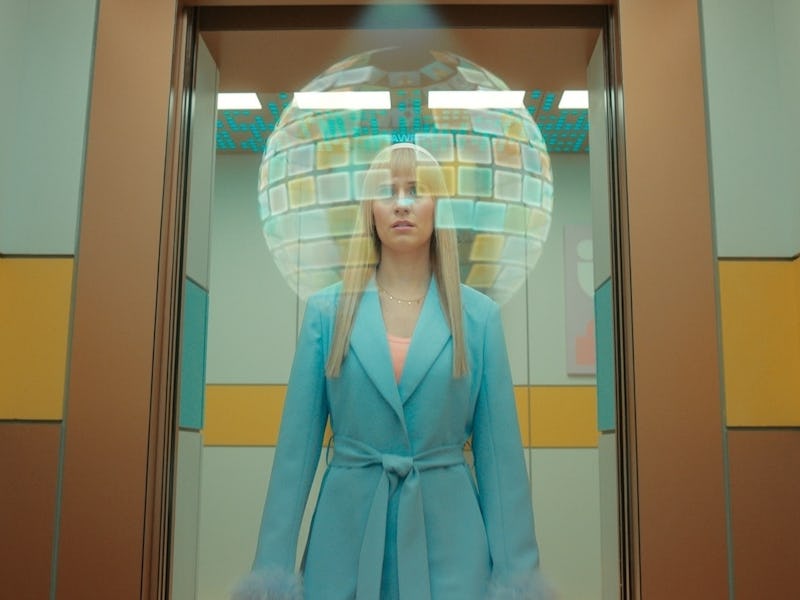Doctor Who is Taking a Page Out of Black Mirror’s Scariest Episode
One futuristic city’s quality of living takes a dramatic nosedive in “Dot and Bubble.”

Doctor Who has never been afraid to dip its toes into some social commentary, and that's especially been true of the show's current era. Not only do the series' 60th anniversary specials from last year both indirectly acknowledge and comment on the conversations surrounding trans rights that are happening right now around the world, but even "The Devil's Chord" touches lightly on the commercial and mental struggles that a lot of artists are currently dealing with.
This week, however, Doctor Who is set to deliver its most direct piece of social commentary in quite some time. The show's latest episode, titled "Dot and Bubble," is a candy-colored adventure set in a social media-addicted futuristic community. Both narratively and aesthetically, it seems heavily influenced not just by Black Mirror, the sci-fi series that has weaponized satire and social commentary better than almost any other modern show, but arguably its scariest episode.
In “Dot and Bubble,” Doctor Who sends viewers hurtling into a futuristic world that doesn’t seem as far away as it should.
Written once again by Who showrunner Russell T. Davies, "Dot and Bubble" takes place in a futuristic city known as Finetime. It follows Lindy Pepper-Bean (Callie Cook), one of the city's young residents, all of whom spend their days using the episode's titular technology — an augmented reality form of social media that keeps Finetime's residents always online and constantly surrounded by their own personal bubbles of digital screens. Finetime's seemingly idyllic status quo is upset when some of Lindy’s friends go mysteriously offline. In typical Doctor Who fashion, it quickly becomes apparent that some overgrown, bug-like monsters may have something to do with the disappearances of Lindy's friends.
The metaphors of "Dot and Bubble" aren't subtle. It's an episode that, among other things, argues that the inherently limiting nature of one's social media bubble isn't just mentally and psychologically damaging, but actually, physically life-threatening. The episode admittedly isn't as cutting as most Black Mirror chapters are, but it does use absurdity to both sharpen and lighten the weight of its ideas in a way that will seem familiar to anyone who has watched that show. It's hard, in fact, to watch "Dot and Bubble" and not be reminded of one of Black Mirror's most chilling episodes, "Nosedive."
Like "Dot and Bubble," "Nosedive" takes place in a futuristic human society where people have become cripplingly dependent on their digital devices. The latter episode imagines a world where human lives don't just revolve entirely around what they see on their screens and social media, but where their very existence is determined by their ever-evolving social credit scores. It's as unnerving a dystopian sci-fi world as basically any that you'll ever see. As is the case in "Dot and Bubble," though, the insidious nature of the world shown in "Nosedive" is masked by its brightly colored pastel aesthetic and the forced smiles of those who live within its bounds.
Bryce Dallas Howard gives one of the best performances of her screen career in Black Mirror’s unforgettable Season 3 premiere, “Nosedive.”
Doctor Who is, obviously, a very different show than Black Mirror. One series traffics in a kind of acidic tone that the other rarely ever indulges in. Doctor Who also routinely uses the presence of silly monsters to soften the edges of even its sharpest social criticisms in a way that Black Mirror almost never does.
All that said, it's refreshing to see Doctor Who so openly and boldly step into the same kind of narrative, tonal, and stylistic place as Black Mirror — if only for an episode. Above all else, "Dot and Bubble" proves that Doctor Who could stand going to slightly darker, more uncomfortable, and even more satirical places in the future. It doesn't need to ever go quite as far as Black Mirror always seems to, but borrowing a few more tricks now and then from its fellow British sci-fi series moving forward certainly wouldn't hurt.